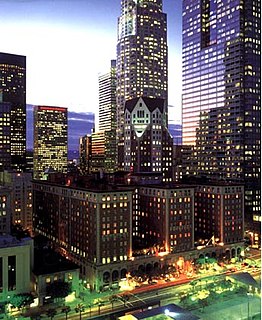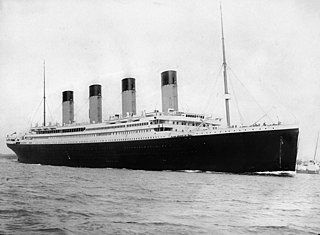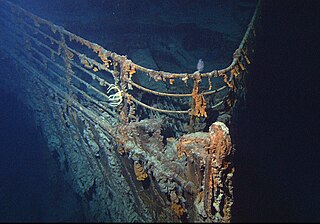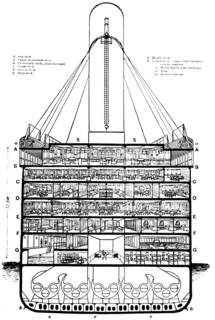
Titanic is a 1997 American epic romance and disaster film directed, written, co-produced, and co-edited by James Cameron. Incorporating both historical and fictionalized aspects, it is based on accounts of the sinking of the RMS Titanic, and stars Leonardo DiCaprio and Kate Winslet as members of different social classes who fall in love aboard the ship during its ill-fated maiden voyage.

RMS Olympic was a British ocean liner and the lead ship of the White Star Line's trio of Olympic-class liners. Unlike the other ships in the class, Olympic had a long career spanning 24 years from 1911 to 1935. This included service as a troopship during the First World War, which gained her the nickname "Old Reliable". She returned to civilian service after the war, and served successfully as an ocean liner throughout the 1920s and into the first half of the 1930s, although increased competition, and the slump in trade during the Great Depression after 1930, made her operation increasingly unprofitable.

A stairway, staircase, stairwell, flight of stairs, or simply stairs, is a construction designed to bridge a large vertical distance by dividing it into smaller vertical distances, called steps. Stairs may be straight, round, or may consist of two or more straight pieces connected at angles.
A newel, also called a central pole or support column, is the central supporting pillar of a staircase. It can also refer to an upright post that supports and/or terminates the handrail of a stair banister. In stairs having straight flights it is the principal post at the foot of the staircase, but the term can also be used for the intermediate posts on landings and at the top of a staircase. Although its primary purpose is structural, newels have long been adorned with decorative trim and designed in different architectural styles.

The Millennium Biltmore Hotel, originally the Los Angeles Biltmore of the Bowman-Biltmore Hotels group, is a luxury hotel located opposite Pershing Square in Downtown Los Angeles, California. Upon its grand opening in 1923, the Los Angeles Biltmore was the largest hotel west of Chicago in the United States. In 1969 the Biltmore Hotel was designated a Los Angeles Historic-Cultural Monument by the City of Los Angeles. Regal Hotels purchased the Biltmore in 1996, and then sold it in 1999 to Millennium & Copthorne Hotels. As of 2009, the Los Angeles Biltmore is operated as part of the Millennium & Copthorne Hotels chain as the Millennium Biltmore Hotel. The hotel has 70,000 square feet (6,500 m2) of meeting and banquet space. From its original 1500 guestrooms it now has 683, due to room reorganization.

The sinking of the RMS Titanic in 1912 shocked the world, and attracted so much controversy that a number of conspiracy theories have been put forward regarding the disaster.

The SS Manhattan was a 24,189-ton luxury liner of the United States Lines, named after the borough of New York City. On 15 June 1941, the Manhattan was commissioned as the USS Wakefield and became the largest vessel ever operated by the US Coast Guard. In 1942, the ship caught fire and was rebuilt as a troop ship. The Manhattan never saw commercial service again.

SS Servia, also known as RMS Servia, was a successful transatlantic passenger and mail steamer of revolutionary design, built by J & G Thomson of Clydebank and launched in 1881. She was the first large ocean liner to be built of steel instead of iron, and the first Cunard ship to have an electric lighting installation. For these and other reasons, maritime historians often consider Servia to be the first "modern" ocean liner.

RMS Campania was a British ocean liner owned by the Cunard Steamship Line Shipping Company, built by Fairfield Shipbuilding and Engineering Company of Govan, Scotland, and launched on Thursday, 8 September 1892.

The Olympic-class ocean liners were a trio of British ocean liners built by the Harland & Wolff shipyard for the White Star Line during the early 20th century. They were Olympic (1911), Titanic (1912), and Britannic (1915). All three were designed to be the largest and most luxurious passenger ships in the world, designed to give White Star an advantage in the transatlantic passenger trade.
Ken Marschall is an American painter and illustrator notable for his paintings of famous ocean liners, such as the RMS Titanic, RMS Lusitania, and the HMHS Britannic, and other transportation vessels including the Bismarck, LZ 127 Graf Zeppelin and LZ 129 Hindenburg. His paintings have been used in many books about the Titanic, most notably his depictions of the sinking, of which no photographs that could be used were taken.

USS Lydonia (SP-700) was United States Navy patrol vessel in commission from 1917 to 1919 that saw service during World War I. Prior to her U.S. Navy service, she had been William A. Lydon's private yacht, Lydonia II, from 1912 to 1917. She spent most of the war based at Gibraltar, escorting and protecting Allied ships in the Mediterranean and along the Atlantic Ocean coast of Europe. After her U.S. Navy service ended, she served from 1919 to 1947 in the United States Coast and Geodetic Survey as the coastal survey ship USCGS Lydonia (CS-302).

RMS Titanic was a British passenger liner operated by the White Star Line that sank in the North Atlantic Ocean in the early morning hours of 15 April 1912, after striking an iceberg during her maiden voyage from Southampton to New York City. Of the estimated 2,224 passengers and crew aboard, more than 1,500 died, making the sinking one of modern history's deadliest peacetime commercial marine disasters. RMS Titanic was the largest ship afloat at the time she entered service and was the second of three Olympic-class ocean liners operated by the White Star Line. She was built by the Harland and Wolff shipyard in Belfast. Thomas Andrews, chief naval architect of the shipyard at the time, died in the disaster.

Conklin Mountain House is a historic home located at Olean in Cattaraugus County, New York. The above ground portion of the main house is a 4,500 sq. ft Second Empire style wood frame dwelling built in 1886. The front facade features a three-story tower with mansard roof and a wraparound porch. The exterior of the home features extensive overhanging eaves, decorative brackets and balustrades. The house sits on top of a 2,000 sq. ft full-height stone basement. The property also includes a 1,600 sq. ft two-story carriage house.

The White Swan Hotel is a hotel in the middle of the historic market town of Alnwick, Northumberland, England. The hotel is a 300-year-old coaching inn and is a Grade II listed building. Its most distinctive feature is the Olympic Suite, a large room furnished with interior decorations from the RMS Olympic that are substantially identical to those aboard her sister ship, the RMS Titanic.

The wreck of the RMS Titanic lies at a depth of about 12,500 feet, about 370 miles (600 km) south-southeast off the coast of Newfoundland. It lies in two main pieces about a third of a mile apart. The bow is still recognisable with many preserved interiors, despite deterioration and damage sustained hitting the sea floor. In contrast, the stern is completely ruined. A debris field around the wreck contains hundreds of thousands of items spilled from the ship as she sank. The bodies of the passengers and crew would have also been distributed across the sea bed, but have been consumed by other organisms.

Reflecting the White Star Line's reputation for superior comfort and luxury, the RMS Titanic had extensive facilities for first-class passengers which were widely regarded as the finest of her time. In contrast to her French and German competitors, whose interiors were extravagantly decorated and heavily adorned, the Titanic emphasized comfort and subdued elegance more in the style of a British country manor or luxury hotel. Titanic's enormous size enabled her to feature unusually large rooms, all equipped with the latest technologies for comfort, hygiene, and convenience. Staterooms and public spaces recreated historic styles with a painstaking attention to detail and accuracy. There was a wide range of recreational and sporting facilities in addition which provided ample opportunity for amusement during a voyage.

Spring Hall, also known as Spring Hall Mansions, is a mansion situated off the Huddersfield Road, Halifax, West Yorkshire. A house had been built on the site by 1614, but it was demolished in 1870 leaving only the cellars. It was rebuilt in Gothic Revival style and completed in 1871 to a larger ground plan by architects James Mallinson and William Swinden Barber for Tom Holdsworth.
Titanic: Honor and Glory is a video game currently under development by Vintage Digital Revival, also known as Four Funnels Entertainment. The game is expected to feature the most accurate digital representation of the RMS Titanic to date, as well as a model of the city of Southampton in 1912. The game is intended to be not only entertaining but also a historical teaching tool, and a memorial to all those who lost their lives in the disaster. The project was originally funded through crowdfunding on Indiegogo and other sites. However, during a podcast on April 10, 2015, director Thomas Lynskey announced that the team would move away from crowdfunding in order to focus more on the game's development.
Second class accommodation and facilities on board the Titanic were actually very intricate, and spacious in comparison to many first class facilities on other ships of the time. Although the second and third class sections of the ship occupied a much smaller proportion of space overall than those of first class, there were several comfortable, large public rooms and elevators for the passengers to enjoy, so much in fact, that the minority of the spaces provided were actually used during the voyage. 284 passengers boarded second class in a ship that could accommodate 410 second class passengers.
























